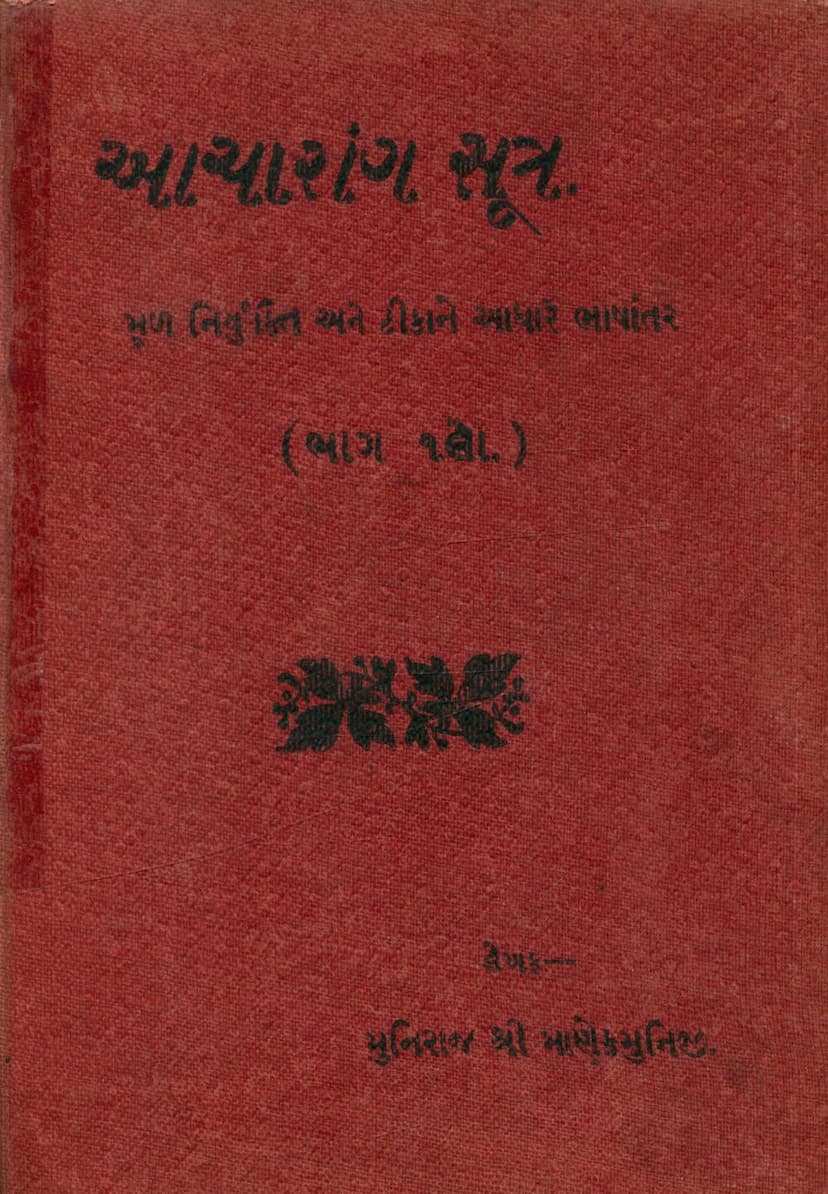Acharanga Sutra Part 01
Added to library: September 2, 2025

Summary
Here's a comprehensive summary of the provided Jain text, "Acharanga Sutra Part 01," based on the provided pages:
Book Title: Acharanga Sutra Part 01 Author(s): Muniraj Shri Manek Muni Publisher: Mohanlal Jain Shwetambar Gyan Bhandar Catalog Link: https://jainqq.org/explore/023092/1
This volume, translated from the original Sanskrit text of the Acharanga Sutra based on the Niryukti and Tika (commentary), is presented as Part 1 of a larger work. The author, Muniraj Shri Manek Muni, expresses his intention to make this fundamental Jain scripture accessible to a wider audience by providing a simpler Gujarati translation.
Purpose and Significance of the Acharanga Sutra (as per the Introduction):
- Foundational Text: The introduction highlights the Acharanga Sutra's importance as a foundational text for Jain monks. Historically, the first study of this sutra was given to a disciple before their initiation to help them understand the nature of the soul and to avoid future suffering by protecting life. While current practice might involve other texts initially, the author emphasizes the continued relevance and utility of the Acharanga Sutra.
- Ethical Guidance for Monks: The sutra's primary aim is to teach monks how to live correctly, ensuring they do not cause harm to any living beings. It meticulously outlines the principles of conduct for Jain ascetics.
- Knowledge for Laypersons: The author also believes that if laypersons (shravaks) understand the conduct of monks, they can guide errant monks back to the right path, just as King Jitasatru brought discipline to his subjects.
- Translation Basis: The translation is based on the original Mool Sutra, the Niryukti by Bhadrabahu, and the Tika by Acharya Shilanka. The author acknowledges prior commentaries, including those by Gandahasti Acharya and the simpler Dipika by Samay Sundar Maharaj, as well as Gujarati translations based on them. He notes that a translation of the Tika along with the Niryukti was not available elsewhere, prompting his effort.
Content Overview of Part 1:
The summary of the content from the index (Pages 7-10) reveals the structure and topics covered in this volume. It is organized into the first Adhyayana (chapter) of the Acharanga Sutra, which is further divided into various sections and verses. Key topics include:
- Introduction and Commentary's Intent: Explaining the purpose of the commentary and the translator's approach.
- Qualities of an Acharya: Detailed description of the thirty-six virtues of an enlightened Jain teacher.
- Analysis of Key Terms: Discussion of terms like "Achar" (conduct) and "Adhyayana" within the sutra.
- Philosophical Concepts: Explanation of concepts like Brahman and Brahmacharya, the four varnas (castes) and their subdivisions.
- Core Principles: Discussions on Parigyna (understanding) and Pratyakhyana (renunciation).
- Detailed Exposition of Conduct:
- Explanation of various "Sutras" (aphorisms) relating to directions, introspection (e.g., "Where have I come from?"), different philosophical viewpoints (363 mats), the importance of time, the nature of fate, and the arguments of soul-believers.
- Illustrative stories like the one about King Jitasatru.
- The nature of different types of existence (earth-bodied, water-bodied, fire-bodied, air-bodied, vegetation-bodied, and mobile-bodied beings) and the suffering of ignorant souls caught in cycles of rebirth (e.g., 8.4 million life forms).
- The concept of divine knowledge (parigyna) as shown by the Bhagwan (Tirthankara) to avoid suffering.
- The principle of non-violence in relation to actions like bowing, showing respect, and worship.
- Detailed breakdown of different life forms (Kaya): The latter part of the volume provides descriptions and explanations of:
- Prithvi Kaya (earth-bodied beings)
- Ap Kaya (water-bodied beings)
- Teu Kaya (fire-bodied beings)
- Vayu Kaya (air-bodied beings)
- Vanaspati Kaya (vegetation-bodied beings)
- Trasa Kaya (mobile beings)
Editorial and Financial Aspects:
- Publisher's Note: The publisher, Zaverbhai Raychand Bangdiwala, highlights that the book is priced at cost to make it accessible. Contributions from various individuals and trusts are gratefully acknowledged for supporting the publication.
- Errata Sheet: A Shuddhipatra (correction sheet) is provided, indicating a commitment to accuracy and a process for improving future editions.
- Support for Jain Education: The text also mentions support for religious schools run by the Gyan Bhandar, indicating a broader mission of religious education.
Overall Impression:
This part of the Acharanga Sutra translation aims to be a rigorous yet accessible rendering of a crucial Jain text, focusing on the ethical and philosophical underpinnings of monastic life and the principle of Ahimsa (non-violence) in its most detailed application. The translator's dedication to clarity and accuracy is evident through his detailed introduction and the reliance on established commentaries. The inclusion of financial and editorial notes underscores the effort behind making this spiritual knowledge available.